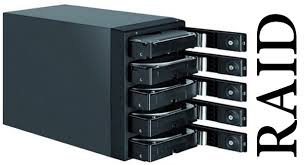If you are studying computer science, you will want to familiarize yourself with storage systems and storage virtualization technology.
Storage systems use hardware, software, and disk drives to provide fast and reliable storage for computing and data processing. Storage virtualization is the process that allows storage to be pulled from multiple sources into a single storage device, a device that can be controlled from a central computer system.

There are numerous benefits to storage virtualization technology. It makes the migration of data faster, reduces the amount of downtime, reduces the number of on-site resources, and creates a better workflow.
Of course, like all forms of technology, there are disadvantages to consider as well. Occasionally, you may find yourself running out of storage room. There are also data security risks if a hacker decides to target your storage system.
One type of data storage virtualization technology you’ll want to familiarize yourself with is RAID. Below is a very basic overview of RAID so that you can begin familiarizing yourself with this technology.
RAID: What is it?
RAID stands for “Redundant Array of Independent Disks”. Using this form of data storage virtualization technology, data is pulled from multiple sources into a single storage device
This technology was created to improve performance for server machines and to provide a level of fault tolerance. Solid-state drives (SSDs) are used to provide data security. SSDs are preferable because they have quick access times, lower latency, are more resistant to physical shock, and also tend to run silently.
RAID configurations connect two or more hard drives. Disk mirroring is used to copied data simultaneously, while striping is used to write data across multiple disks. Depending on the RAID configuration, some combination of disk mirroring and striping will be used.
A brief history of RAID
The term RAID was first invented in 1987 by David Patterson, Garth Gibson, and Randy Katz. They were studying the possibility of using multiple disks to appear as a single device to the host system. At the time, it stood for Redundant Arrays of Inexpensive Disks.
It was cheaper to buy multiple single mainframe hard drives than it was to buy a bigger mainframe computer. So, they wanted to show that it was cheaper and efficient to connect single mainframe hard drives than to buy multiple larger mainframe computers.
RAID systems remain popular to this date, though RAID now stands for Redundant Array of Independent Disks.
Different RAID levels
There are various standard RAID levels, though some RAID levels are referred to more than others. Here are some of the most common RAID levels that you should be familiar with.
RAID 0 (Disk Striping) is when data is split evenly across two or more disks. RAID 1 (Disk Mirroring) is when identical data is mirrored between multiple drives. RAID 5 (Striping with parity) strips data across disks but also stores parity information. RAID 6 (Striping with double parity) is similar to RAID 5, but with increased reliability. And, finally, RAID 10 (Striping + Mirroring) is a combination of RAID 0 and RAID 1.
Calculating disk space and speed
If you’re interested in calculating the capacity of a disk array, you will need to know the RAID level, drive capacity, drive cost, drives per RAID, and the number of RAID groups. Knowing these calculations can help you decide what RAID configuration is right for you.
You can use a RAID speed calculator to help you make the calculations. Most calculators will be able to do calculations for all common RAID levels.
RAID for backups
Some people wonder if their RAID configuration counts as a backup. The answer is no. Even if you’re using a RAID configuration, you are going to want to back up your drives.
RAID can protect against disk failure, but it does not protect against errors, file corruption, RAID controller failure, or malicious attacks. You do not want to make the mistake of relying on your RAID configuration for backups.
You can pair your RAID configuration with other software to fully protect your system. To fully backup your data, you’re going to want a recoverable copy of your data on a hard drive that is separate from your RAID set-up. Storing data in multiple places is the only way to fully protect your data.
In summary
RAID is a type of storage virtualization technology that pulls data from multiple sources into a single storage device. It is used to connect two or more hard drives. However, while there are many benefits to using a RAID configuration, it is important not to rely on a RAID array as a backup system. As you continue to study computer science, you will want to develop a deeper understanding of RAID.

